#Tipping Practices In Iceland
Explore tagged Tumblr posts
Text

In Iceland tipping is not what you might call a generally accepted practice as it just ends up being part of the bill. Nonetheless tips of 10% even on a very good service is always appreciated at restaurant cafes and with tour guides. No need to tip the taxi drivers but if you do someone a favour than round up the fare.
0 notes
Text
Hot & cold
Heyy hello! This is my first time ever doing this kind of post, esp on Tumblr :,D. So forgive me if this will seem pretty messy! Again, this is my first time posting on here and I'm not a native english speaker 💔
Men DNI
Context: reader and Sevika are born in COMPLETELY different regions. Reader - in the cold, blizzaring north; Sevika - in the warm, sweltering South of Asia. And their differences in temperature come clashing against each other, sometimes one of them poking fun at the other (all gits and shiggles ofc).
Warning/content: reader is mainly interpreted as fem, modern!AU (?? idk), soft!Sevika, sfw
A/N: reader is basically just based on my arcane oc lmfaoo (I'm having such bad Sevika x oc brainrot rn)
・✧ You and Sevika have always gotten along, even before you two moved in together into an apartment. Of course, you two had your differences, but they never really clashed against each other. Except for one thing - the climate you two grew up in.
・✧ Of course, all humans are warm-blooded. That's just basic biology. But the climate you grew up with, especially if it's harsh like the cold weather in Iceland, or the heat of India, you'd start craving the opposite temperature. That's basically how you two grew up separately, until moving to a different region, one that sits practically in the middle of both opposite climates, and meeting each other.
・✧ The first instance of this was you two walking together, late night in the city. A cold breeze flew across you two and both had very different reactions to it. You shivered from it, while Sevika was pleased with it. "My God, that was cold." you blurred out, wrapping yourself up with both of your hands. "A good kind, at that." Sevi grinned. You side-eyed her slightly, your hands still around your shoulders, "No, seriously, I'm quite literally freezing right now.". She looked back at you, slightly confused at how you felt differently from that small gust of wind. But then she covered you with her jacket, not wanting you to somehow catch a cold from that.
・✧ Whenever you two go to bed, you practically cling onto Sevi because of how warm she is, while you also have the blanket covering you up to the tip of your ears, especially during the colder seasons (you may even have two blankets covering you atp). All while Sevika's barely covered by it, which she doesn't mind at all. She'd just nuzzle herself into the crook of your neck, if needed a little warmth. One would sometimes ask if the warmth/cold isn't bothering the other, and the answer would always be no. Maybe even a little teasing included.
・✧ Whenever colder seasons arrive, you'd have like two shirts layered underneath a sweater and tights and socks underneath your pants. While Sevika doesn't double up the clothing like you. Even when going out, you'd have like a warm winter coat and two scarves layered on you and Sevi wears just a coat. You'd always warn her that she'd be freezing without at least a scarf, but she'd just shrug it off and tell you "Don't worry, I wont." (she does end up freezing a couple times).
・✧ Pretty similar scenario goes for warmer seasons. If the temperature's 15 degrees Celsius or higher, you'd immediately be wearing a tank top or something similar and would want to go outside. "Weather's great today, we should go out.", you say as you turn around and see your girlfriend practically melting on the couch. "How the hell can you handle this heat..?" Sevika groans while holding something cold on her forehead. You give her a cold drink after poking fun at her a bit.
Sorry if this may have been a little non-logical 🥲 this little idea popped up out of nowhere and wanted to share it. Will probably add more later, if this'll do any numbers lol
26 notes
·
View notes
Text
Holy spaces & shrines in the modern norse path
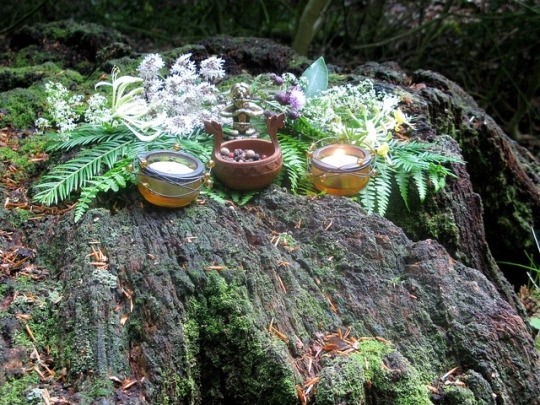
Before we dive into the oh-so-diverse topic of holy spaces, let me first specify a few practical tips!
I’m very much aware that the definition of the term “holy” is deeply subjective and varies depending on one’s opinions. I’ll elaborate on a few of my thoughts on the topic further!
In no way are you bound by any rule regarding this aspect of paganism.
I will base my post off of my research, granted, but also on my personal experiences and practices!
Now, what makes a holy space sacred? Not necessarily "holy" per say, but simply sacred.
The very first factor to consider is, what is sacredness? Lots and lots of pagans engage mostly in solitary practice, so much is true. Which is why lots of us find ourselves gravitating towards spaces others may not necessarily find any sense of "sacredness" in. The corner of your room where you tend to pray the most? Sacred. Or the spot in your garden where you perform your harvest ritual every year! It’s the connection we feel to the space that makes it sacred in the first place. But a space being holy depends on whether or not we choose to anoint it in such a way.
When something is sacred to me, I tend to feel a sort of spiritual pull. A swelling of the heart, if you will, like the feeling I get when faced with a breathtaking landscape. The feeling of spiritual connection to a particular spot is the first intuition one needs to tune into when choosing a holy space. After all, staying in tune with one's intuition might be one of the most important aspect of any spiritual practice.
Within nordic practice, a holy space is often called vé, a sacred enclosure. Vé's are attested in numerous toponyms as well as ancient texts, such as Beowulf, or the Skáldskaparmál. Their omnipresence in Scandinavian toponyms might, when considered through a pagan lense, signify something quite interesting: the holiness of a space depends on the space itself, its location, rather than what's inside it— or rather, how grand and ornate it is. When building a holy space for oneself, one does not need lavish decoration, or an elaborate shrine with the gold foil and the statues.
However, there are a few steps one can follow in order to anoint a space as holy, if one wants to reconstruct a few practices from pre-Christian Scandinavia. Although I'll specify that as always, no rule is set in stone when it comes to neopaganism. The choice to abide by them or not is entirely up to the practitioner. And in any case, even as I was gathering these few ideas, it was clear that, as always, pre-Christian practices centered around holy spaces vastly differed depending on the place and the time. Regardless, I think it's fun to do some research on the topic in order to reconstruct on our own terms a holy space in the nordic tradition.

The first step? Having a good knowledge of your area. Both before and during the Viking Age, holy places were more often than not located outside. It can be a great help to know where to find the greenery in one's area. Is there a beach near home that the public has access to? How about a large park where you can spend some time alone without being bothered? Even your backyard does the trick! Anywhere you can see the sky and breathe the open air is already perfect. Now, the Germanic tribes would generally worship near an object of particular importance, such as a grove, a body of water, a clearing in the forest, a hill... Although this doesn't seem to be very present in historical attestations, and considering I'm devoted to Yngvi-Freyr, I'm an especially big fan of worshipping in plains, or fields!

I think it's important for me to note that if you are lucky enough to live near a body of water, you can choose to engage in one of the most popular forms of offering in nordic historical practice: throwing offerings out to sink into the water! This practice was especially widespread, evidence of it having been found as far as Britain and Iceland. Evidently, if one chooses to engage in such a practice, it's important to respect the ecosystems and stick with offerings that won't damage them (acorns, stones, flowers and the like). As for an outdoors shrine located in a forest, or near woodland, it would have been customary during pre-Christian times to center a holy space around a tall tree, perhaps representing the World Tree Yggdrasil.

Considering lots of neo-pagans prefer to keep their practice discreet, it goes without saying that the holy space of your choosing does not need to be especially big, nor especially decorated. It can be as small as it is humble! One of the spaces where I most like to worship is the little corner of the yard, tucked under a cedar tree, where I rebuild my hörgr every year, as soon as the snow melts for good. Nothing too flamboyant!

Now, the second step to building a little outdoors shrine for yourself is to choose a representation of the deity to adore. It's said that the human-like appearance of this representation mattered little to the Germanic tribes, whose representations of the Gods could be rather simple, and not especially ornate. For this reason, it would be perfectly logical to even choose an object associated with the deity in question to serve as the main representation placed in the sanctuary. If we're talking about Freyja, a falcon statuette, or feather could do the trick! As for Fenrir, any wolf imagery could work as well! In the case of Thórr, one could replicate the case of Donar's Oak and choose to center their shrine around a particular tree (the rowan are the oak would make the best choices, if one is to pick a tree sacred to Thórr). These are just examples, and the possibilities in this regard are limitless. This "main" representation can be used as the center of your sacred space, and given offerings during rituals or celebrations. In my case, I like greet this representation both when "entering" the sacred space and when leaving it, as a sign of respect!

If one so desires, it's possible to set up some kind of "delimitation" in order to mark the entrance of the sacred space, or its outline. I like to place either ribbons on nearby branches, or litter stones here and there to lie in a loose circle (we wouldn't want to block the rays of the sun from reaching the earth and keep the greenery from growing). In order to signal the entrance of shrines, the Germanic tribes would generally use heaps of dirt or pillars of stone, among other things.
Another intresting element one might include in their sacred space is the presence of fire! Whether this be a bonfire, incense, a simple candle or even just a handful of ash, there's lots of ways to include the "element" of fire into a modern day shrine. It's a means of warming up the space, so to speak: tending a fire in the shrine is akin to having a hearth in the home!
Ideas for common, historically attested offerings: Ethically-sourced animal bones, gold or golden jewelry, tools, representation of the Gods, beads and beaded jewelry, alcohol, food and meat…

Now, let's pull away from the history lesson and let's dive into modern, neo-pagan practice! I'd wager some of you are wondering, how exactly can one keep a whole shrine, but make their practice as low-key as possible?! After all, I know firsthand that solo practice is especially common among neo-pagans. So my answer to this question is, who said anything about keeping? One piece of advice I've already given to a few fellow pagans in the past is to create a little portable shrine all to yourself! Let me explain myself: you arrive at your chosen location, you put down a basket full of decoration and you put up a temporary space in which to worship for an hour or two. You take out a deity representation, a few candles (if they're allowed on site!), a handful of offerings and a cloth on which to place them. And when you're done with the ritual, you pack up your things and make sure you leave the site as clean as when you first found it. In other words, what I’m suggesting is the possibility of gathering a few designated worship items in order to make oneself a portable, personal little shrine! It might seem like a silly idea at first, but I’ve discovered it’s not only a fun habit, but it’s also greatly helpful on a tight schedule to have a quick and easy way to engage in outdoors practice.
As always, I wrote this post aiming to help fellow pagans find ways to balance historical practice and modern, solo practice! I hope these few ideas did the trick, and wish you all a good and plentiful spring season!
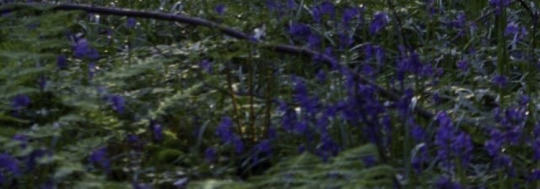
First picture
#heathenry#norse paganism#spirituality#norse gods#polytheism#deities#deity work#paganism#pagan#norse polytheism#history
135 notes
·
View notes
Text
It's Dadmark + Sonland time!
Before the headcanons, just a quick commentary on their relationship according to my AU.
Iceland is 100% without a doubt Denmark's favourite. Denmark recognises that his role as the leader of the Nordics means that playing favourites is probably a little risky, so he tries not to be too obvious about it.
Denmark really does try to not be obvious, but whenever anything happens it's painfully obvious that the first person he thinks of is Iceland.
Iceland is a teenager, so I really don't like the idea of him living alone. I know he has this whole 'independent adult' thing, but he's a kid. Usually, he stays with Norway, but sometimes he'll live with Denmark for a while which Denmark absolutely loves.
I'd like to think that he and Norway get into petty (and unserious) arguments over raising Iceland.
While Iceland does prefer living with Norway because it's a much more peaceful environment and he gets much more freedom, Denmark's place is a lot less stressful for him because he has much less responsibilities because he doesn't have to practically confiscate Norway's coffee when he tries to test his immortality by drinking like 20 cups a day.
Alright, that was a brief explanation, now let's get on with the headcanons!
-Denmark loves getting to teach Iceland things. He taught him how to ride a bike, he occasionally likes giving him cool chemistry lessons (Denmark absolutely loves science, particularly chemistry) and he teaches Iceland how to cook.
-Iceland loves coming to Denmark with good news because he always makes a big deal about it which Iceland secretly loves.
-Denmark is the best at breaking Iceland's whole 'I'm too old for ---' thing because he knows what will absolutely make him laugh like a child (for those who are curious here's a short list : prolonged, wide-eyed eye contact, tickling, horribly incorrect use of slang ex: 'that is very gyatt of you')
-Denmark and Iceland always wake up much earlier than anyone else, so they always get at least 3-4 hours of one on one time until the others wake up. Denmark loves using this time to take Iceland on fishing trips where he'll teach him good fishing tips as well as life lessons.
-Denmark feels especially guilty that Iceland spent a good chunk of time alone from birth until Norway found him, so he tries to make it up by babying him which Iceland is most accepting of when it's Denmark.
-Denmark refers to Iceland as his son whenever he's talking about him to a stranger or another nation. Iceland calls Denmark his dad whenever he talks about him. Neither of them is aware that the other does this, and they'd both absolutely melt if they found out.
-Denmark is unbelievably great at shutting down Iceland's self depreciation even if he puts it as a joke.
-no one can get Iceland in trouble if Denmark is around. You can't even so much as give this kid so much as a mildly mean comment without Denmark giving you a look that suggests that you keep it to yourself if you'd prefer to keep your head attached to your body. He is wildly protective of Iceland.
Alright, that's it for now, I'll probably do more later because this is my favourite Duo ever.
20 notes
·
View notes
Text
It can be difficult and tedious, complicated and confusing, so I tried to organize what I believe to be the most important information about the AU in order

It's best to start with the names of the Starfolk kind and names of main four
Lightmares here are called Tairnsteal, a mix of the Gaelic words tairn (thunder) and bristeal (shard), forming the name Thunder Shard.
The name of a Lightmare, Aithris, means Echo in Gaelic
Angels are called Himinsker, which means Cutting Sky, where himin means sky and skera (cut/slice) (from Old Norse)
The name of Angel, Ealeit, is a blend of the Gaelic Eala (swan) and the Irish Cleite (feather)
Demon kind is known as Losgwaear, meaning Earth Burners, a combination of the Welsh llosgwr (burn) and draear (earth)
The name of Demon, Raudar, from raudur that means red or crimson in Icelandic
Dark Paladins are called Falfain, Guardian Fire derived from Gaelic words meaning fal (guardian) and fain (fire).
The name of a Paladin, Sadris, is an attempt to blend the Gaelic dris (thorn) and sradadh (striking/sparking)
Now, a bit about the geopolitics of this world. The six locations are only a small part of this universe - essentially, the border between two kingdoms. These small regions function as independent states, though it's more accurate to describe them as fiefs under a central capital.
For the Darkfolk, this capital is Crimson Ash, while for the Lightfolk, it is Radiant Alder. These are the seats of the ruling Starfolk, who decide which Hight Lords will be assigned to oversee each fief. Many years before the main storyline begins, a Losgwaear named Duartag (from du - black, and artag- small stone, gaelic) ruled the fief containing Flaming Spire
A Bit of Starfolk History
The history of the Starfolk is divided into several eras, each defined by the ruling powers in the capitals and their approach to managing the conflict. At times, the conflict would quiet down, only to flare up again later. Some rulers implemented a system where selected individuals could systematically and strategically switch polarities, but later, this practice was completely forbidden. In some eras, settlements were established where Darkfolk and Lightfolk lived together, only for these communities to be erased in the next era
In the final era, the conflict escalated to the point where both sides reached the same conclusion: the war would only end when one race was completely wiped out. However, this truth was known only to select elites within each faction, while the common folk remained ignorant, experiencing the war as they always had
Religion and the All-Seeing
The Worldless in this setting is referred to as the All-Seeing, and the ruling class - especially the Hight Lords - are revered as semi-divine beings. This belief stems from a single fact: Starfolk cannot die naturally, but the ruling elite possesses the power to kill them. Because of this, Lords are believed to have a direct connection to the All-Seeing, acting as mediators between god and the ordinary Starfolk, enforcing divine justice
But this is a lie, a fabrication of the ruling class. No Lord has ever communicated with the All-Seeing, nor have they been granted the power to kill. Their ability to do so comes solely from shards of the Cusp of the Worldless, which shattered upon impact. These fragments are embedded in the tips of sacred weapons (knives, spears), hidden from view and designed to be removable and carried discreetly. This precaution exists because if someone were to steal a weapon and attempt to use it on a Lord, they would be shocked to find that it didn't work - reinforcing the belief that only Lords control the fate of the Starfolk. Some Lords take this deception further, creating tiny needles or hidden overlays on their hands or fingers, making it seem as though they can kill with a mere touch. This secret is entrusted only to the most loyal and capable members of both races - no one outside of the Lords may know the truth. But Duartag thought differently. Fanatically loyal and consumed by madness, he decided to reveal the secret to younger Losgwaear in order to fulfill the vow of this era:
"Only the death of light will scatter our sorrow."
Duartag believed that by entrusting the sacred weapons to more Darkfolk (though still limiting them to Losgwaear), he could accelerate the extermination of the Lightfolk. However, the methods he used crossed all limits and ultimately failed to achieve his goal
Now, we gradually approach the events that led to the convergence of these four in the AU
There’s an important detail about how these four kinds come into existence. Tairnsteal and Falfain are born fully grown, but with one key difference - they can choose when to be born. However, they typically appear only when a Himinsker or Losgwaear is born, forming a kind of bond, swearing to protect their chosen Starfolk and becoming their lifelong companion. That said, this "choice" of birth has a nuance. While they can decide when to emerge, they still need time to grow and develop. Sometimes, they sense the impending birth of a higher-ranking individual and instinctively prepare themselves to be their guardian. However, if they are still immature at that time, they remain inside their "shells" until they fully mature and have the chance to bond with another Starfolk. Because their numbers are so small, having a living weapon as a companion is considered a privilege. Occasionally, some Tairnsteal and Falfain are born without bonding to anyone, but this is rare and only happens under specific conditions
In most cases, all adult Starfolk can "awaken" others of their kind from their star cores, but in the case of Himinsker and Losgwaear, only their own species can do so
This is where everything began. Duartag was impatient. Knowing that the birth of Losgwaear took a long time, he decided not to wait and began forcing them out of their shells prematurely - which led to catastrophic consequences.
1. Losgwaear were born underdeveloped, suffering from severe physical flaws. They were much smaller than they should have been, plagued by illnesses that made daily life difficult
2. Falfain could not bond with any of them because Losgwaear had not chosen to be born. This broke the natural cycle, leaving many Falfain without purpose
Duartag also decided to forcefully awaken Falfain as well, without allowing them to bond naturally. Some survived, but most perished - leading Duartag to abandon the experiment and declare Falfain to be useless attachments. For Falfain, their entire existence revolves around serving and protecting Losgwaear - this instinct is ingrained within them. But without a direct purpose, they were left lost and aimless
For those like Sadris, being forcefully awakened was especially difficult. Although his physical form held up better than the Losgwaear, he was defective in his own way. Falfain are naturally fragile to compensate for their hardened shells and the ability to form any weapon, but in Sadris’s case, his fragility was far worse than average. He could still do everything a normal Falfain could, but his weak condition and constant migraines forced him to rely more on strategy and precision rather than brute strength
Without a natural bond, the abandoned Falfain had one last hope - to earn recognition through a newly created ranking system, something that never existed before because Falfain had always been above such classifications. By climbing the ranks, they hoped Duartag would choose some of them for his apprentices, despite his disdain for their kind. This was the only way they could secure a role in the war and prove their worth - otherwise, they would remain without purpose, without bonds, and without meaning
Life under Duartag was miserable for Raudar and his fellow Losgwaear. Losgwaear were far from ideal protectors of the Starfolk, showing little respect for lower ranks - or even for members of their own kind. But under Duartag, things were far worse than usual. One of the first things Duartag did to his apprentices was "purge" their imperfections. Normally, lost or damaged body parts in Starfolk would regenerate over time, but Duartag found a way to make these losses permanent by using shards of Cusp. Because of this, Raudar lost his wings - they had been underdeveloped due to his premature birth, but under normal circumstances, they would have grown in properly. He should have been able to use them
Losgwaear resemble dragons in appearance, and Raudar was meant to be lean and tall, but since the mass that should have gone into his wings was distributed elsewhere, it resulted in a bulkier upper body. This, in turn, caused problems - his hands would tremble uncontrollably, making him feel like as if they could disappear at any moment
Duartag’s methods didn’t stop at mutilation. He relentlessly tormented his apprentices, pushing them to their limits and leaving countless scars on their bodies. Because of this, Raudar refused to wear loose or revealing clothing, instead choosing strict, fully covered outfits to hide his wounds. Duartag tried to instill hatred toward the Lightfolk, making it clear that their purpose in this era was to exterminate them. However, instead of fueling Raudar’s hatred for the enemy, it only deepened his hatred toward Duartag and his own kind. Raudar was not blind to what was happening in the Flaming Spire. He realized that some of the captured Lightfolk could have been Darkfolk who had successfully changed their nature. Even if they weren’t, killing them robbed some Darkfolk of the chance to make that transformation themselves. Another sign that they were doing something wrong was the fact that these executions were carried out deep underground, far from the sight of the All-Seeing. It was as if even they knew their actions were unjustifiable
By law, Raudar could have challenged Duartag to a duel and claimed his position as the Hight Lord. However, he was far too weak to win in direct combat. Instead, he set his sights on a different position of power. Aside from the Lords, each fief domain had another powerful figure - the High Priest. These priests managed internal affairs and sometimes held even more influence than the Lords themselves, despite the general population's stronger loyalty and they sometimes have more power than the Lords. If Raudar could become the High Priest, he would be in a position to "soften" the situation in the Spire and eventually remove Duartag when the opportunity arose.
However, the path to becoming High Priest was difficult. To be eligible, a Losgwaear had to reach Rank 1 and hold the top spot for a certain period before they could challenge the current Priest. This was a highly unstable position - rankings constantly shifted, and the weakened generation of Losgwaear made it even more difficult to maintain a secure lead. Even worse, Raudar wasn’t the only one with plans for change - others were also fighting for this position, making the struggle for power even more intense
Regarding the other side, the Lightfolks’ situation remained calm, aside from the growing stress caused by the Darkfolks' goals, the disappearance of the sisters, and the ongoing battles for control over the Mountain Bastion. This stronghold was a key strategic point that would give them an advantage over the Darkfolks, to whose kingdom it originally belonged. Well, “belonged” - the Lightfolks had already managed to seize more than half of the area, leaving the Darkfolks with only a small fragment of land. However, the situation could change at any moment
Aithris's life took a turn for the worse when she chose her Himinsker, the companion she was supposed to protect. Unfortunately, her Himinsker lost the very first battle, reversing polarity with her opponent. Because of this, others began to treat Aithris with cold detachment, seeing her as weak for failing to protect her companion - especially in the first fight. As a result, she was kept apart from the other Starfolks for a long time
Ealeit, on the other hand, was fiercer and more radical. While this meant she never formed close relationships with her sisters - who kept their distance out of caution - it also earned her admiration. Especially since their High Lady took notice of her, seeing her as a gift in these troubled times and believing that perhaps more warriors like Ealeit were needed. In the end, Aithris was assigned to her, considering that tairnsteal had been without a partner for a long time and that Ealeit herself needed support in battle. Together, they formed a powerful fighting duo, assigned to the strongest unit in their army. They became so formidable that among the Darkfolks (particularly the Losgwaear) they gained a fearsome reputation as the main scourge of their kind. This made them both feared and highly sought after, as capturing them would significantly increase their value
Raudar had never encountered Ealeit on the battlefield himself, but he had heard plenty of stories and witnessed the aftermath of her battles. In a way, he was even grateful to her and developed a certain sentiment toward her - because after his brothers suffered a crushing defeat against her, their ranks dropped several levels, allowing him to climb higher in the hierarchy. Though, at the same time, he was aware of that one day he might face her in battle - and suffer the same fate
Their meeting was anything but typical. One day, Ealeit was assigned to patrol the Soaring Gardens, which were relatively close to the Flaming Spire (at least in terms of how the transition screens were arranged in the game). She was accompanied by another Lightfolk who greatly admired her. However, the Lightfolk constant chatter was getting on Ealeit's nerves (and Aithris’s too). Still, Ealeit couldn’t just bluntly tell her to shut up, especially since the Lightfolk ranked higher than her (Not that she would have done it even in a normal situation, no matter how much she wanted to). Instead, she suggested splitting up to cover more ground
Flying near the border, she unexpectedly ran into Raudar and Sadris, and before she could react, Sadris knocked Aithris right out of her hands. Without her partner, Ealeit was terrified, though still ready to fight the two Darkfolks at once. However, the attack never came. Raudar made no move to strike; instead, he tried to engage her in conversation. This only confused and angered her, making her snap back at him, though she gradually started forming longer responses. After all, her Tairnsteal was still in the hands of a Falfain, and she had no idea how this situation might end - especially since Sadris hadn’t yet attempted to absorb her
They didn’t have long to "talk," though. Raudar’s patrol was approaching, and he told her that, despite her reputation, she wouldn’t stand a chance against eight Darkfolks at once. He advised her to leave before she got caught in the range of the Darkfolk’s natural radar. Before parting, he added that if she ever wanted to talk again, she could meet him in the same place in two days
Ealeit was torn. Should she accept or reject this "invitation"? She had been taught never to trust Darkfolks, told that they were naturally manipulative toward Lightfolks—an ability no one could explain and, for some reason, no one could resist. Curiosity got the better of her, though she remained wary. Raudar was indeed waiting there. Without even greeting him, Ealeit immediately asked why he hadn’t attacked her. He replied that neither of them would have come out of it unscathed - and that he also wanted to thank her for clearing his way up the rankings
Half-joking, he then told her about his real intentions: his desire to change the situation in the Spire, to improve the Darkfolks’ condition without relying on absorption. He thought she might be interested - and that she could even help him. Ealeit was unimpressed and was about to leave when Raudar asked her to give him more time. She refused, pointing out that they had no time to waste - and that they were standing in an open area where anyone could see them. He then suggested meeting next time in the Mountain Bastion caves. The area was unstable due to the conflict, but the caves themselves were largely unexplored, and no one ventured there. (Ironically, they would be hiding right under the noses of both warring sides. From a certain angle, that could even be an advantage - since the Starfolks were too preoccupied with matters aboveground)
Meeting there several more times, Raudar gradually revealed his plan. They could change the tides of the war by securing high-ranking positions. He even told her that she was strong enough to challenge their High Lady and take a superior rank. However, out of respect and love for her mentor, Ealeit refused. Instead, she decided, just like him, to aim for the position of High Priestess
#worldless#worldless au: transcendence#worldless angel#worldless lightning nightmare#worldless demon#worldless dark paladin
8 notes
·
View notes
Note
I just have to ask, but what is your secret to write a 3k story in such a short amount of time???
in general i have a very quick writing speed but my general process looks something like this:
when starting, you want to know what you start the chapter with and what you want it to end with everything in between this can be figured out after you know the beginning and end
the outline is vague, have fun with it. making it silly makes it easier to follow, for example my outline for chapter 2: bittersweet looks like this

make time for the story. writing a sentence at a time will most likely not create the flow in the story that you want, find an hour or more just to focus on writing and you can more easily write 1000 words in one sitting (helps you get in the flow as well)
find non distracting music to listen to, i listen to múm, an experimental icelandic pop band
when I am writing and ideas for further chapters come, I will write down their outlines. So while I am still working on chapter 3, I have outlines nearly all the way to chapter 6, doing this while i am writing helps me figure out when events will occur
and my last tip is to write what you want to write, if you are working on one story but really want to work on another, there is no shame on working on two projects at once. It will help you get into flow if you first work on what you reall want to.
This might all seem very generic stuff but it works like a charm, atleast for me it does, but practicing writing speed and being cozy and relaxed while writing is always nice
3 notes
·
View notes
Text
Eco-Conscious Escapes: Sustainable Tourism Destinations
Sustainable Tourism: A Greener Way to Travel
Sustainable tourism is a growing trend that focuses on minimizing the negative impacts of tourism on the environment and local communities. By making conscious choices as travelers, we can help protect our planet and support sustainable practices.

Why Sustainable Tourism Matters
Environmental Protection: Sustainable tourism helps to protect natural resources and reduce pollution.
Economic Benefits: It can generate income for local communities and support sustainable livelihoods.
Cultural Preservation: It helps to preserve local cultures and traditions.
How to Be a Sustainable Traveler
Here are some tips for sustainable travel:
Choose Eco-Friendly Accommodations: Look for hotels and resorts that are committed to sustainable practices, such as reducing waste and conserving water.
Minimize Your Carbon Footprint: Consider traveling by train or bus instead of flying, and choose eco-friendly transportation options at your destination.
Respect Local Cultures: Dress modestly, learn basic phrases in the local language, and respect local customs and traditions.
Reduce Waste: Minimize your use of single-use plastics, bring reusable water bottles, and avoid excessive packaging.
Support Local Businesses: Buy from local markets and shops, and choose locally owned restaurants and cafes.
Volunteer: Consider volunteering with local organizations to help protect the environment and support community initiatives.
Sustainable Tourism Destinations
Many destinations around the world are embracing sustainable tourism practices. Here are a few examples:
Costa Rica: Known for its lush rainforests, stunning beaches, and diverse wildlife, Costa Rica is a popular destination for eco-tourism.
Iceland: This Nordic island nation offers breathtaking landscapes, geothermal wonders, and sustainable tourism initiatives.
New Zealand: With its stunning natural beauty, clean air, and commitment to sustainability, New Zealand is a top destination for eco-conscious travelers.
Bhutan: This small Himalayan kingdom prioritizes sustainable development and offers a unique cultural experience.
The Galapagos Islands: A UNESCO World Heritage Site, the Galapagos Islands offer incredible wildlife encounters and a commitment to conservation.
By making conscious choices and supporting sustainable tourism initiatives, we can help protect our planet and ensure that future generations can enjoy its beauty.
#travel#sustainability#sustainable#sustainable tourism#eco tourism#responsible travel#green travel#sustainable destinations#trips
2 notes
·
View notes
Text
Paper Icelandic Poppies
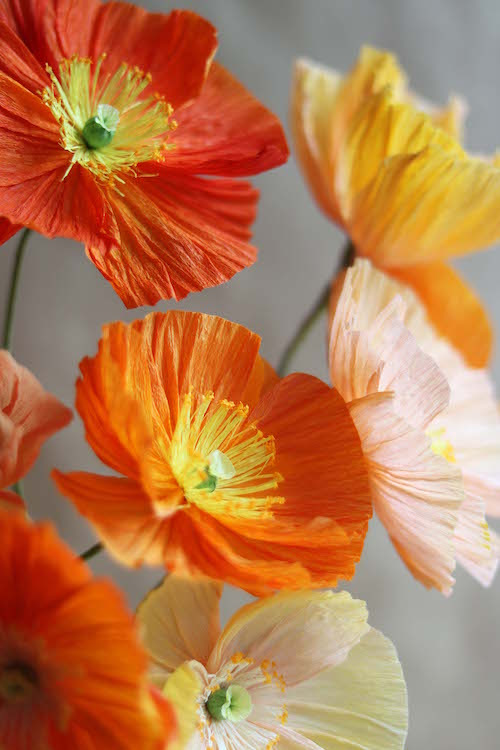
Project by Kate Alarcón:
There’s a particular kind of lady-slipper orchid that I have made and remade and adjusted and readjusted. I’ve probably made a hundred little green orchid slipper prototypes, and each try is more frustrating than the last. At this point, I suspect that the minute I finally do figure out this orchid, I’ll make it and then crumple it up, just to vent my irritation.
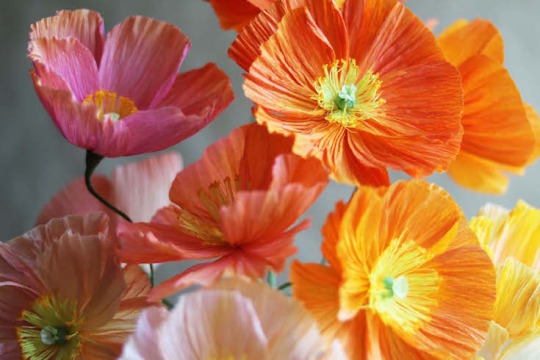
The Icelandic poppy is another flower that I feel like I’ve never completely nailed down. I’ve been tinkering with this version for over a year now. But unlike the lady-slipper, just about every attempt at this poppy has been really fun. I think it’s because poppies — with their wrinkled petals and hairy, spindly, crooked stems — are gloriously awkward. My practice poppies could carry off every little eccentricity I inflicted on them with rumpled panache.
I hope you’ll make your own awkwardly glorious bouquet of poppies and stick them in a vase and fuss with them as they tilt their blooms at weird angles, and lean all over the place, being disagreeable. And just when you’re about to throw up your hands, you’ll step back and realize that it’s all come together. You’ll want to make more.
The crinkle technique I describe below is adapted from Livia Cetti’s gorgeous and essential book, The Exquisite Book of Paper Flowers.
Special thanks to the phenomenally talented Lynn Dolan (@lmdolan75 on Instagram) for her generous advice on this project! —Kate

Photography by Kate Alarcón
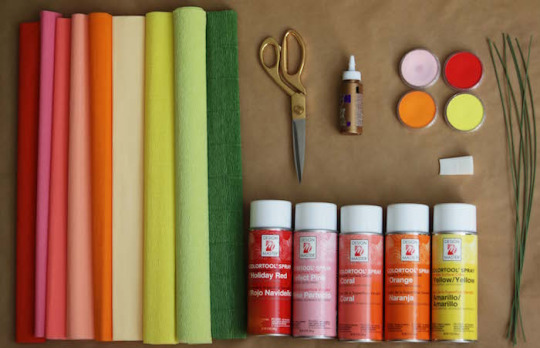
Supplies
-18 gauge cloth-covered floral wire -8mm wooden beads -white cosmetic wedge sponges for applying glue -sharp scissors –poppy templates
Crepe paper
This is what I used, but definitely feel free to mix it up and substitute.
From Castle in the Air:
-“Pale Yellow Green” heavy crepe for the frill at the top of the seed pod -“Lemon” heavy crepe for the stamen filaments -“Sunflower” fine crepe for the anthers at the end of the stamens -Fine crepe in “Red,” “Persian Pink,” “Pale Pink,” “Pink,” “Sunflower,” and “Vanilla” for the petals
From Paper Mart:
-“Moss Green” heavy crepe to cover the pod and wrap the stem, from Paper Mart
Optional:
Design Master Color Tool Spray in “Holiday Red,” “Perfect Pink,” “Coral,” “Orange,” and “Yellow”
PanPastel in “Permanent Red Tint 340.8,” “Permanent Red 340.5,” “Orange 280.5,” and “Hansa Yellow 220.5”

A note about grain:
The grain of the crepe paper runs parallel to the roll or fold. You will almost always cut petals with the grain, placing the template so that the tiny wrinkles in the paper run up and down the template, not across. Each template includes an arrow to show the direction the grain should run.
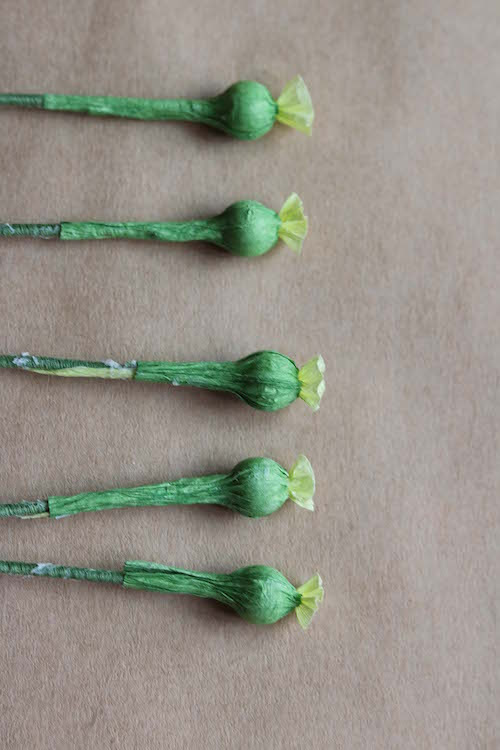
Constructing the seed pod at the center of the flower:
The first step is to create the little frill at the top of the seedpod. Use template A to cut a frill piece from the pale green heavy crepe. Stretch the wider end of the piece all the way out, flattening all the little crinkles in the upper half inch of the frill piece.
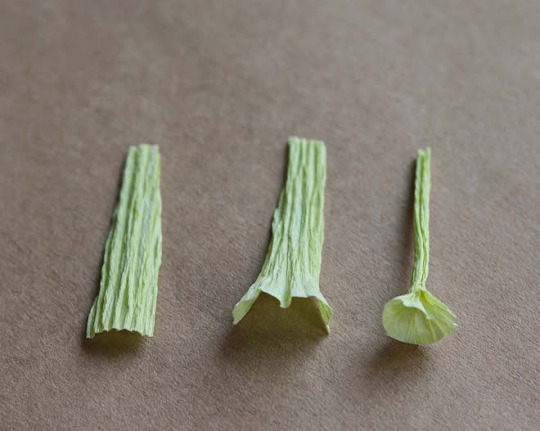
Twist the frill piece, beginning about ½” below the top edge. The part of the frill that you stretched will form a little funnel. As I twist, I like to place my fingertip inside this funnel so that it stays open.

If this feels cumbersome, it’s fine to just twist and then use one end of your floral wire to reopen the funnel.
Insert the twisted bottom part of the frill piece into your wooden bead.
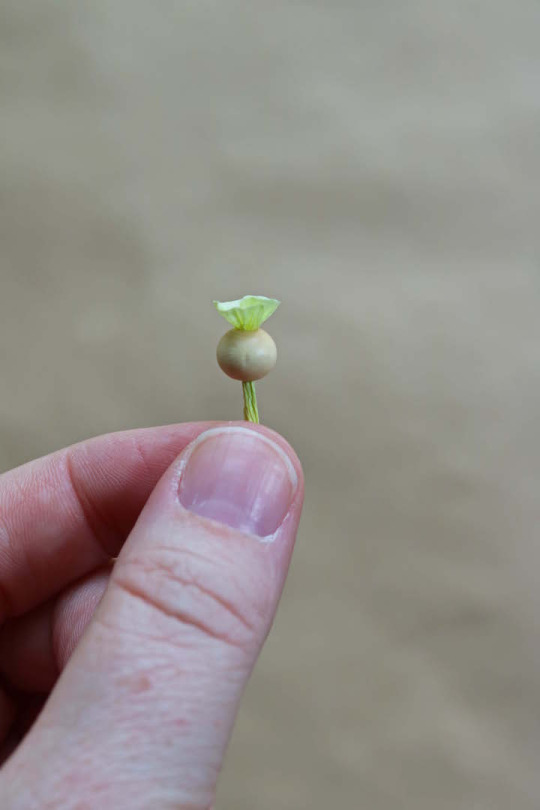
Dip the tip of your wire in the glue and scrape off any extra so that you have a thin coat that isn’t dripping all over the place. Insert this wire tip into the bottom of the bead, next to the bottom of the fringe that you’ve just inserted.
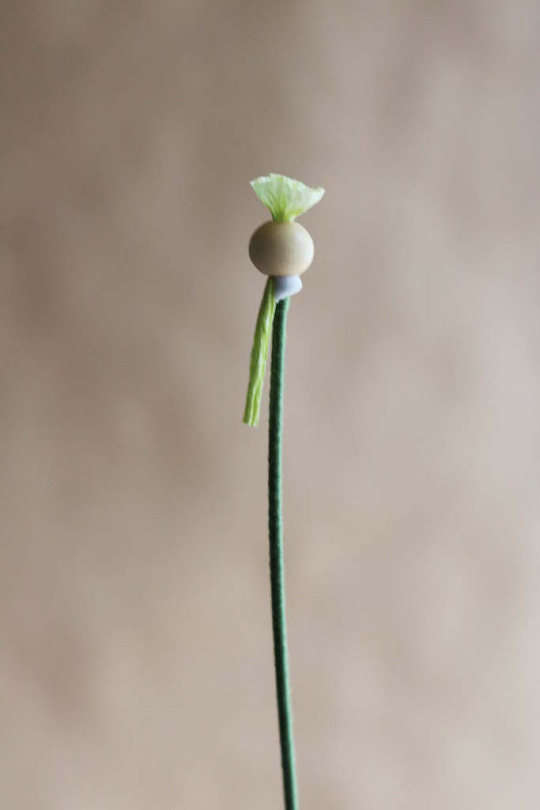
You don’t need to push this all the way up into the bead. You’re mostly just trying to anchor the wire tip inside the bead. You’ll secure it in the next step.
Use template B to cut a rectangle from the medium green heavy crepe. Snip a very short fringe across the top of this rectangle (it’s fine to freehand this, but you can also use the lines drawn across the top of template B).
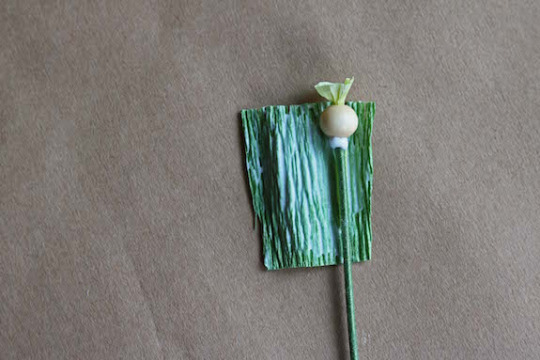
Use your sponge to swipe a thin layer of glue over this piece. Lay your bead on top of the rectangle, so that the top edge is slightly higher than the top of the bead. Stretch the rectangle around the bead and press either side together.
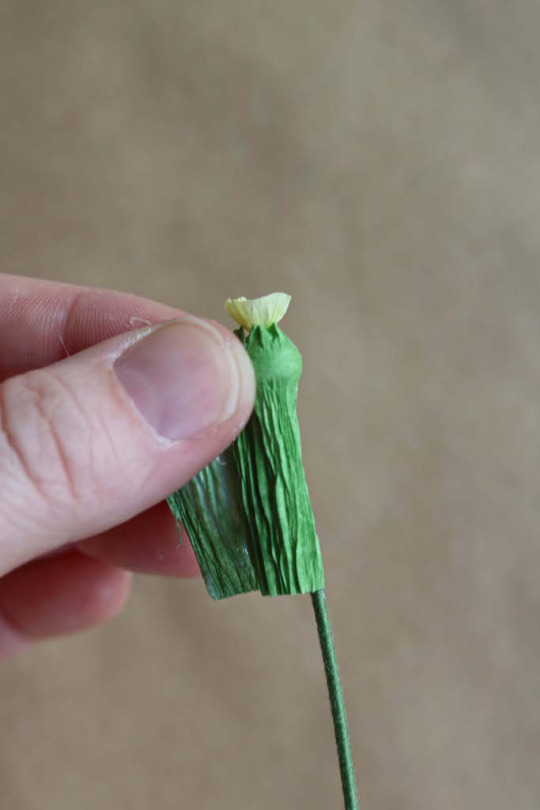
Trim the excess rectangle.
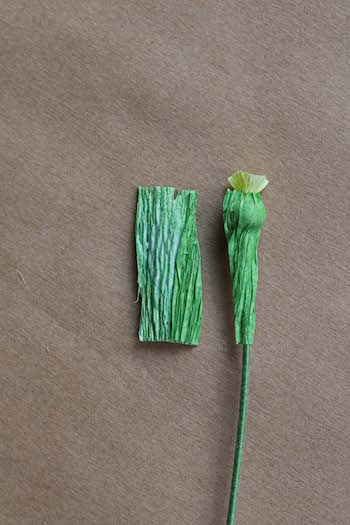
Use your fingers to press the fringes of the green crepe down onto the top of the bead. Scrunch the green paper beneath the bead around the wire.
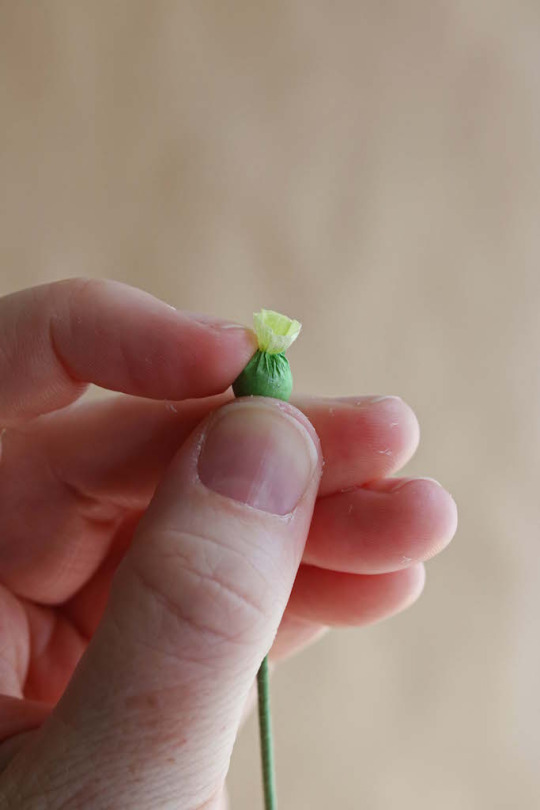
This will secure the pod to the wire.
For the stamens:
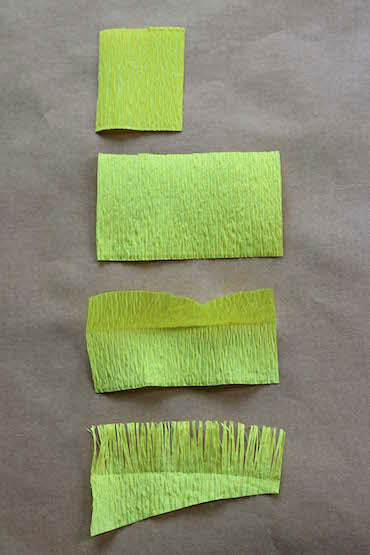
Use template C to cut a rectangle from the pale yellow, heavy crepe. Stretch this rectangle all the way out. It should now be the same width as template D, but if it’s wider, trim any excess. The dotted line across template D shows how deep you should cut the fringe. (You’ll be cutting from the top). You can trace this line with a pencil or just fold along it and let the crease mark where your fringe should stop.
Without stressing out about it, cut the fringe as finely as you can.
Using the diagonal line on template D as a guide, cut away some of the excess paper beneath your fringe. This will create less of a bump where you’ve applied your stamens, and also smooth the transition from stem to blossom.

Use your wedge sponge to apply glue to the area beneath the dotted line. Place your bead on this fringe piece, so that the bottom of the bead sits just above the dotted line. Roll the fringe around the bead loosely.
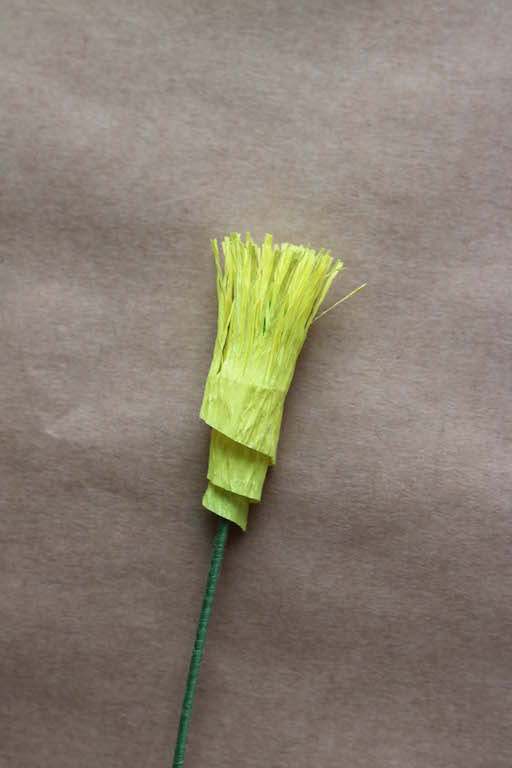
Don’t worry about what’s happening below the bead; just focus on making sure that the fringe at the top is even all the way around.
Scrunch the bottom of the fringe around the wire all the way up to the base of the pod.

Gently pinch the filaments between your thumb and forefinger and bend them away from the center, all the way around, creating a tidy ring of stamens.
Now you’ve got your stamen filaments ready to go!

Cut a 3”x 9” rectangle from the orange fine crepe (the short sides will run parallel to the grain.) Fold it in half vertically and in half vertically again.

Cut a fine fringe through all these layers, turn it 90 degrees, and cut across your fringe to create a fine “confetti.” Gently sweep this confetti into a little pile.
Squirt some glue onto a paper plate or disposable dish, and dip the ends of the yellow fringe into the glue.

To keep my seedpod frill clear of the glue, I prefer to hold the stem at a 45 degree angle and dip one section of the fringe at a time, slowly twirling it to glue all the way around.

Dip your fringe into the pile of confetti. Now your filaments have anthers!

Adding color:
You can apply color before or after you cut your petals.
If I’m using the Color Tool spray, I prefer to color sheets of paper ahead of time. Though the odor fades after a couple of days, this stuff smells really intensely like bug spray when you first apply it, so I strongly recommend doing this outside, preferably with a mask on.
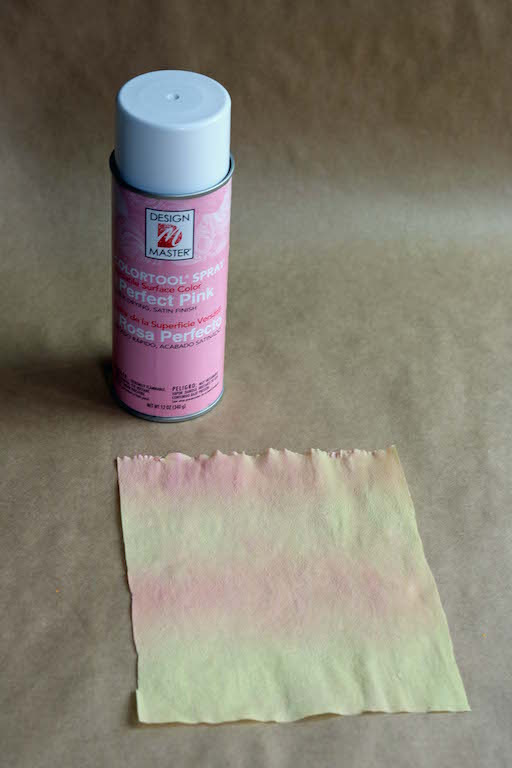
Shake the can well, and spray on a light coat. If you’d like more intense color, let the first coat dry a little bit and then spray on another light coat. I like to spray rows of color across the grain of my paper, spacing them a little bit farther apart than my petal height.
If I’m using PanPastels, I usually cut and then color my petals. Use your cosmetic sponge to swipe the pastel onto the petal, swiping with the grain of the paper.
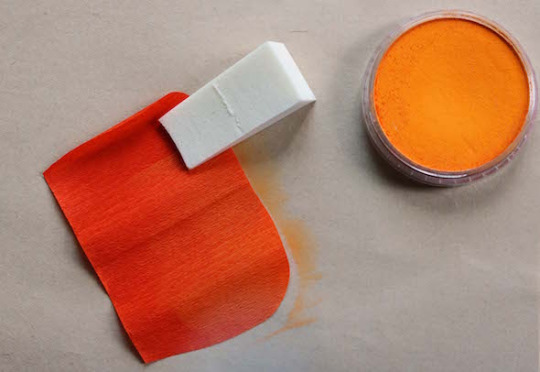
I especially like to apply it so that the color is more intense toward the petal edges, fading toward the bottom, though you could also reverse that.

Clockwise from top: 1. “Vanilla” crepe with “Holiday Red” spray, 2. “Red” crepe with “Orange” PanPastel, 3. “Sunflower” crepe with “Holiday Red” spray, 4. “Vanilla” crepe with “Orange” spray, 5. “Light Pink” crepe with “Yellow” spray, 6. “Vanilla” fine crepe with “Perfect Pink” spray, 7. “Persian Pink” crepe with “Coral” spray, and “Persian Pink” crepe with “Holiday Red” spray.
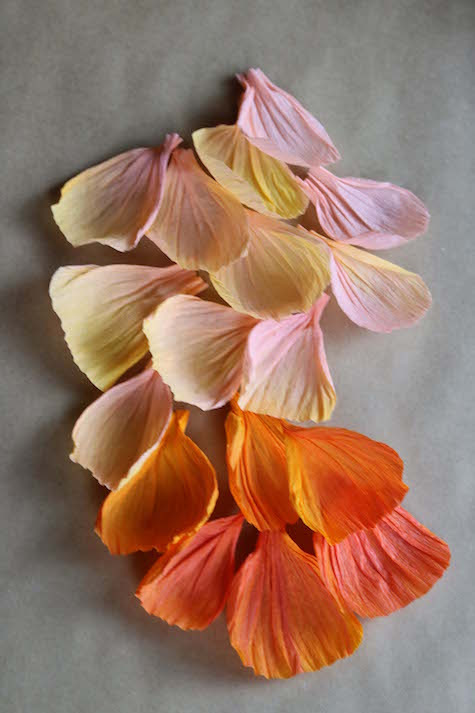
For the petals:
Each poppy will have six petals: two from template E, two from template F, and two from template G. Templates E through F are actually half a petal, so you’ll need to fold your fine crepe parallel to the grain and place the dotted line along the fold.
Lay the petal on a smooth surface. Place your fingertips about an inch in from the edge of the petal closest to you. Place your thumbs right on the edge, behind your fingers. Use your thumbs to drag or inch the paper toward your fingers. When your thumbs and fingers touch, leave your thumb where it is, lift your fingertips and set them down about an inch forward. Repeat until you’ve gathered the whole petal into pleats.
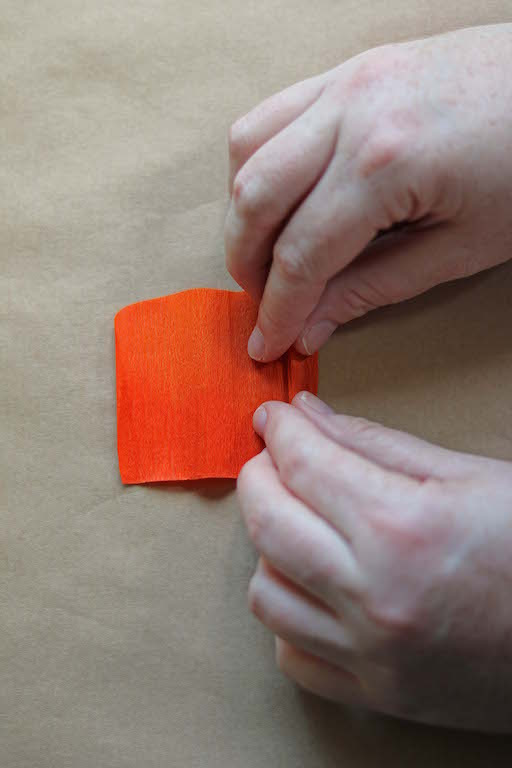
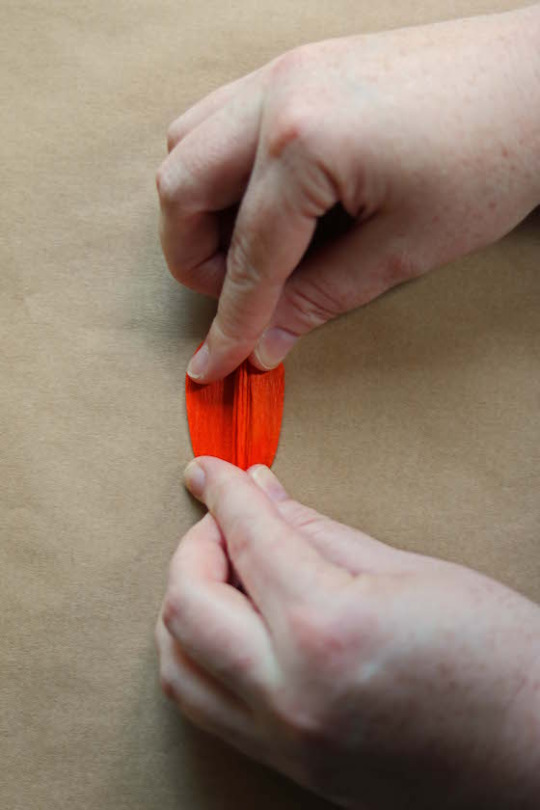
Pick up your gathered petal and pinch up and down it to set the pleats.
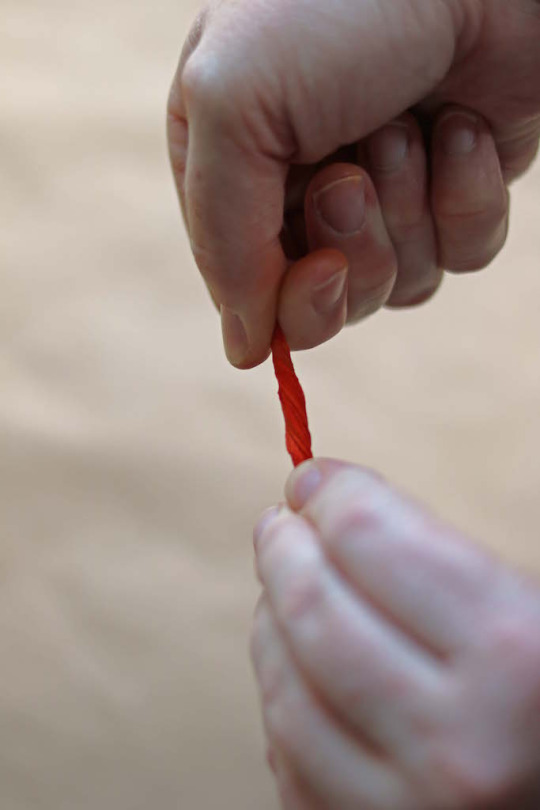
Holding the pleats in place, twist the petal as though you were gently wringing water out of a rag. You’ll twist them pretty firmly, but I find it works better to use a lot of little twisting motions than to try to do everything all in one big twist. Untwist and gently spread the petal, taking care not to smooth the tiny pleats and wrinkles very much.
You can curl your petal at this point or after you glue your pleats.

Curling the petals is a lot like curling ribbon for giftwrap: you can scrape the petal with the blade of your scissors, a skewer, or just your fingers, moving from the base of the petal to the upper edge as you scrape.
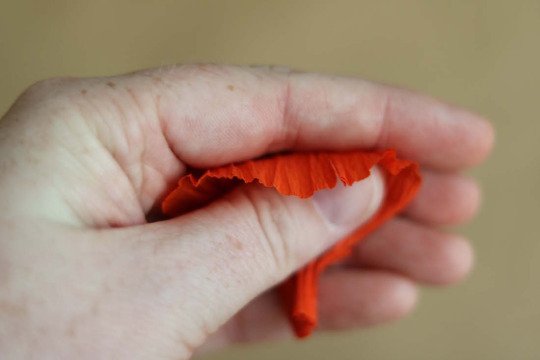
Spread the bottom half inch of the template most of the way out and use your sponge to dab glue all the way across the bottom of the petal.
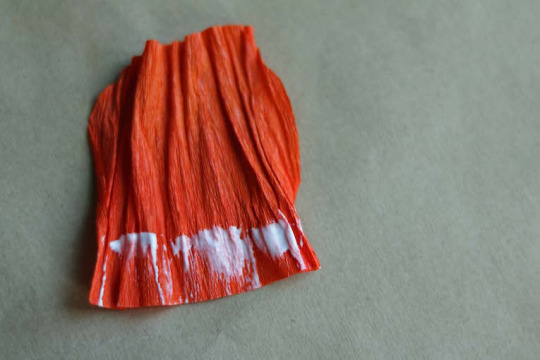
Pinch the bottom edge to gather it back up. Let the glue dry for a few minutes.
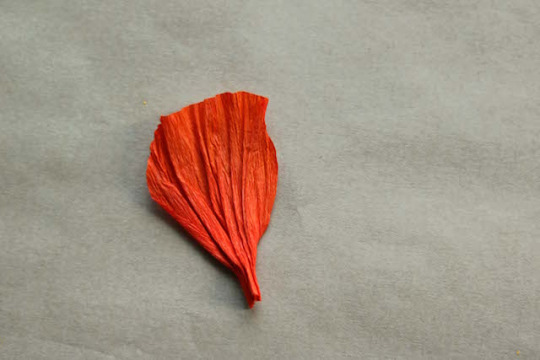
Snip off the excess bulk at the bottom of the petal.
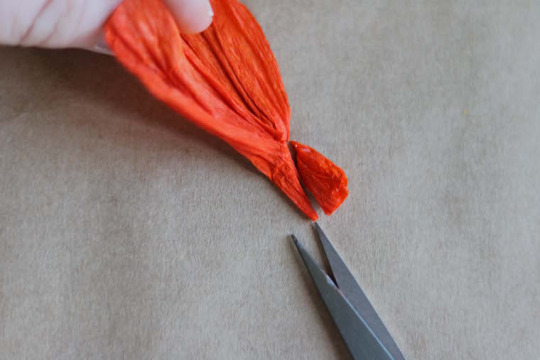

Attaching the petals:
You’ll apply the petals in pairs. Start with the template E’s, and place them on opposite sides of the pod. Apply a little bit of glue to the base of the petal and press it right up under the bead.


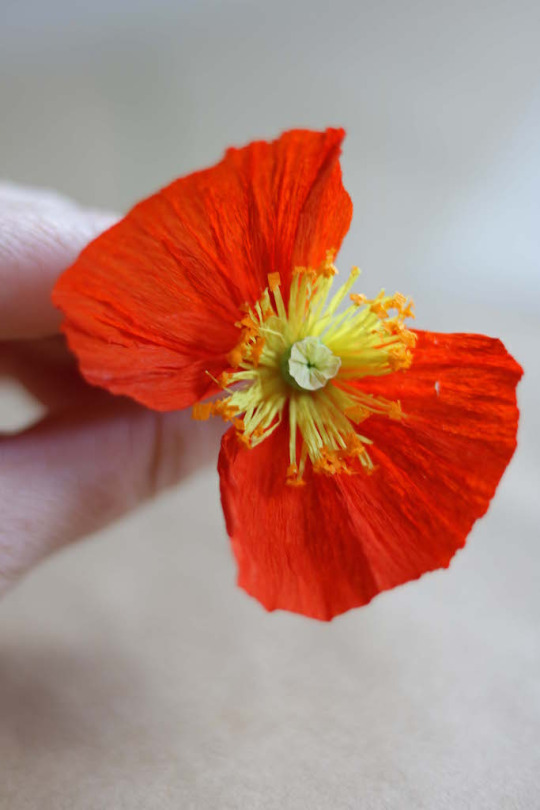
The second set of petals, the F’s, come next. Working clockwise, place each F beside each E, so that each F overlaps each E by about 30 percent.

Finally, apply each template G petal beside your template F petals, again overlapping by about 30 percent.

Finishing your flower:
Cut a few ¼” x 8” strips across the grain of the medium green heavy crepe. Dab glue on the first two or three inches of the strip and tightly wrap the section of the stem just beneath the flower to secure the petals and hide the petal bottoms. Apply a small amount of glue to one side of the stem wire. (I usually glue four or five inches of the stem at a time so I don’t get as much glue on my hands.)
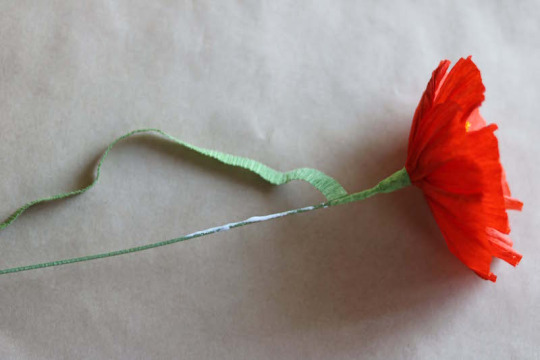
Hold the strip at a 45-degree angle to the stem and gently stretch the strip as you twirl the stem, spinning the strip all the way to the bottom. If your strip breaks or runs out, just begin with a new strip right above the place on the stem where your previous strip ended.
Once the glue is dry, take some time to straighten your stamens and arrange your petals. You might want to curl some a little bit more, or gently tug a petal’s edge to straighten out crumpled pleats, or press some of the petals down where the petal meets the center to separate the layers.
Sources for supplies:
Michaels: 18 gauge floral wire, Design Master spray, wooden beads, glue
Castle in the Air: Crepe paper, glue, wire
Paper Mart: Crepe paper
Blick: PanPastels

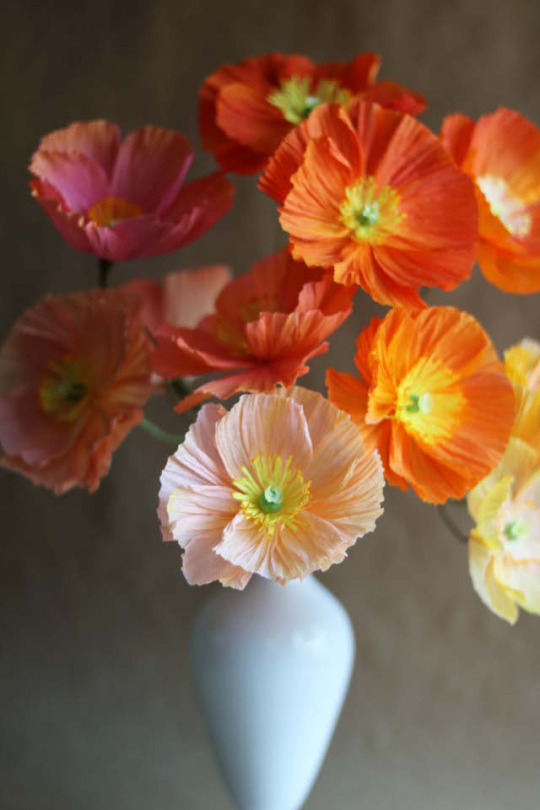
17 notes
·
View notes
Text




The Arab Slave Trade. The Arab slave trade was the practice of slavery in the Arab world, mainly in Western Asia, North Africa, East Africa, and certain parts of Europe (such as Iberia and Sicily) during their period of domination by Arab leaders. The trade was focused on the slave markets of the Middle East, North Africa and the Horn of Africa. People traded were not limited to a certain race, ethnicity, or religion, and included Turks, Iranians, Europeans, and Berbers, especially during the trade’s early days. During the 8th and 9th centuries of the Fatimid Caliphate, most of the slaves were Europeans (called Saqaliba) captured along European coasts and during wars. However, slaves were drawn from a wide variety of regions and included Mediterranean peoples, Persians, peoples from the Caucasus mountain regions (such as Georgia, Armenia and Circassia) and parts of Central Asia and Scandinavia, English, Dutch and Irish, Berbers from North Africa, and various other peoples of varied origins as well as those of African origins. Toward the 18th and 19th centuries, the flow of Zanj (Bantu) slaves from East Africa increased with the rise of the Oman Sultanate based in Zanzibar. They entered trade conflict and competition with Portuguese and other Europeans along the Swahili coast. The North African Barbary states carried on piracy against European shipping and enslaved thousands of European Christians. They earned revenues from the ransoms charged; in many cases in Britain, village churches and communities would raise money for such ransoms. The government did not ransom its citizens. SCOPE OF THE TRADE Historians estimate that between 650 and 1900, 10 to 18 million people were enslaved by Arab slave traders and taken from Africa across the Red Sea, Indian Ocean, and Sahara desert. The term Arab when used in historical documents often represented an ethnic term, as many of the “Arab” slave traders, such as Tippu Tip and others, were physically indistinguishable from the “Africans” they enslaved and sold. Due to the nature of the Arab slave trade, it is impossible to be precise about actual numbers. To a smaller degree, Arabs also enslaved Europeans. According to Robert Davis, between 1 million and 1.25 million Europeans were captured between the 16th and 19th centuries by Barbary corsairs, who were vassals of the Ottoman Empire and sold as slaves. These slaves were captured mainly from seaside villages in Italy, Spain, and Portugal and also from more distant places like France or England, the Netherlands, Ireland and even Iceland. They were also taken from ships stopped by the pirates. The effects of these attacks were devastating: France, England, and Spain each lost thousands of ships. Long stretches of the Spanish and Italian coasts were almost completely abandoned by their inhabitants, because of frequent pirate attacks. Pirate raids discouraged settlement along the coast until the 19th century. Periodic Arab raiding expeditions were sent from Islamic Iberia to ravage the Christian Iberian kingdoms, bringing back booty and slaves. In a raid against Lisbon in 1189, for example, the Almohad caliph, Abu Yusuf Yaqub al-Mansur, took 3,000 female and child captives, while his governor of Córdoba, in a subsequent attack upon slives in 1191, took 3,000 Christian slaves. The Ottoman wars in Europe and Tatar raids brought large numbers of European Christian slaves into the Muslim world too. From a Western point of view, the subject merges with the Oriental slave trade, which followed two main routes in the Middle Ages:……….. #Africa
2 notes
·
View notes
Photo
Porvoo
City in Finland

A view of buildings in the Porvoo Old Town, including the Porvoo Cathedral
Porvoo is a city and a municipality in the Uusimaa region of Finland, situated on the southern coast about 35 kilometres east of the city border of Helsinki and about 50 kilometres from the city centre. Porvoo was one of the six medieval towns of Finland, along with Turku, Ulvila, Rauma, Naantali and Vyborg. Wikipedia
Population: 50,610 (Jul 31, 2020), City rights: 1347 or c. 1380, Region: Uusimaa, Sub-region: Porvoo sub-region
Porvoo - Wikipedia
Auroras

The aurora or northern lights over the Víkurkirkja church at Vik in Iceland on a clear night.
An aurora also commonly known as the northern lights (aurora borealis) or southern lights is a natural light display in Earth's sky, predominantly seen in high-latitude regions (around the Arctic and Antarctic). Auroras display dynamic patterns of brilliant lights that appear as curtains, rays, spirals, or dynamic flickers covering the entire sky.
Aurora - Wikipedia
Auroras in Finland
Finland is one of the best inhabited regions in the world for viewing northern lights, i.e. auroras.

Where
Finland is on the southern rim of the auroral oval. The probability for seeing auroras is best in the northernmost part of the country, i.e. in Lapland. During geomagnetic storms the auroral oval expands southward and then auroras are seen also in Central and Southern Finland.
The statistical probability for seeing auroras during a dark and cloudless night is approximately:
at Kilpisjärvi: 75 % of nights
in Lapland (e.g. ski resorts Ylläs, Levi, Saariselkä): roughly 50 % of nights
in the central part of Finland (e.g. Oulu, Kuusamo): roughly 25 % of nights
on the south coast (e.g. Helsinki, Turku): once in a month on average.
When

The typical time for auroral displays is at midnight, and a couple of hours before and after. However, auroras may occur randomly anytime when the sky is dark enough for seeing them.
Auroras occur quite evenly throughout the year, although the rate is slightly higher during spring and autumn than during winter and summer. However, in summer the nights are generally too light for seeing the auroras. Especially so in Lapland, where the sun does not set at all during a period around midsummer. Considering also the weather, the best time for seeing auroras in Northern Finland is in March and early April.
The solar activity, which varies with the 11-year sunspot cycle, also affects the frequency of auroras. The amount of large auroral displays tends to follow the amount of sunspots with a lag of a couple of years. The previous sunspot maximum was in 2014, so the winters of 2015–2017 are excellent time for auroras. This solar cycle effect is most pronounced in Southern Finland. In Lapland auroras are quite common always, even during solar minimum.
Real-time information

All-sky camera image from Kevo, northern Lapland. The image is not updated during daylight hours.
ISES RWC Finland provides real-time information on the level of geomagnetic disturbances in Finland. Geomagnetic activity is closely linked with auroras: when the activity level exceeds a location-specific threshold, it is probable to see auroras (weather permitting). Following the magnetic activity serves as nowcasting: when activity reaches a "red" level in the service on the station closest to you, it is time to go out to watch the sky.
Nighttime, the service also displays images from selected all sky cameras in Finland.
Tips for aurora watching

Find a dark, open place preferably far away from town lights. As auroras are most often seen on the northern sky, try to find an unrestricted view at least toward the northern horizon.
Optimal weather for watching auroras, dark and cloudless night, is practically always cold in Finland. Dress very warmly.
Lying on a mattress may be a more comfortable way to gaze up than bending your neck backward for lengthy times.
Auroras in Finland - Finnish Meteorological Institute (ilmatieteenlaitos.fi)

Aurora Borealis In Porvoo Finland (by Jari Johnsson)
11K notes
·
View notes
Text
In Iceland tipping is not what you might call a generally accepted practice as it just ends up being part of the bill. Nonetheless tips of 10% even on a very good service is always appreciated at restaurant cafes and with tour guides. No need to tip the taxi drivers but if you do someone a favour than round up the fare.
0 notes
Text
Explosive Fun: How Crazy Cattle 3D Redefines Battle Royales
Sick of battle royales that feel like carbon copies, stuffed with loot crates and pay-to-win traps? Crazy Cattle 3D, crafted by solo developer Anna (@ 4nn4t4t), is here to shake things up with its hilarious premise: you’re an explosive sheep, blowing yourself up to knock rivals off the map. With destructible arenas, tight physics, and no microtransactions, this indie gem is redefining what a battle royale can be. Let’s explore why Crazy Cattle 3D is the chaotic, skill-based game you need to try.
The Wild World of Crazy Cattle 3D
Imagine a battle royale where you don’t shoot guns or build forts—you explode. In Crazy Cattle 3D, you play as a sheep with a knack for self-detonation. Your mission? Use the spacebar to blow yourself up, launching other sheep off the map while surviving the mayhem. You steer with WASD through 3D arenas inspired by real-world landscapes, like Ireland’s cliffs, Iceland’s lava fields, and New Zealand’s rocky hills.
These arenas aren’t static backdrops—they’re destructible playgrounds. Platforms collapse, lava pits shift, and hazards like falling rocks keep you on edge. Matches run about 30 minutes, offering a perfect mix of quick chaos and deep, competitive play. It’s simple to pick up but tough to master, making it ideal for gamers of all skill levels.
What Sets It Apart
Precision Physics: The game’s physics engine is chaotic yet skill-based, making every explosion and tumble feel rewarding.
Dynamic Power-Ups: Speed boosts, sticky bombs, and mega-explosions add strategic depth and fuel epic moments.
Evolving Arenas: Destructible maps mean the terrain changes mid-match, forcing constant adaptation.
Pure Skill, No Gimmicks: No pay-to-win nonsense—just fair, competitive fun.
Why It’s a Viral Hit
Crazy Cattle 3D is more than a game; it’s a cultural spark. Even in alpha, its polished visuals and tight controls have ignited a wave of fan art, Twitch streams, memes, and parody songs. Clips of sheep soaring into lava or pulling off insane sticky-bomb plays dominate X and other platforms, with fans joking about iconic sheep like #25. The game’s humor and accessibility make it a streamer’s dream, with 30-minute matches delivering non-stop entertainment.
The community’s love for the game is palpable. Players share strategies, post fan art, and create memes that keep Crazy Cattle 3D trending. Anna’s solo effort has struck a chord, proving that a single developer can create something truly special. Its addictive gameplay and lack of microtransactions only add to its appeal.
How It Reinvents the Genre
Most battle royales follow a predictable formula: scavenge, shoot, survive. Crazy Cattle 3D throws that out the window. Instead of weapons, you have explosions. Instead of static maps, you get destructible arenas that evolve with every match. The result is a game that feels fresh and unpredictable, with a focus on skill over luck or wallet size.
Compared to games like Fortnite or PUBG, Crazy Cattle 3D is leaner and more accessible, with no complex systems to learn. Its physics-driven chaos echoes Gang Beasts, but the strategic depth of its power-ups and maps sets it apart. The game’s humor, centered on explosive sheep, adds a layer of charm that’s hard to find elsewhere.
How to Excel in Crazy Cattle 3D
Want to dominate the arenas? Try these tips:
Perfect Your Detonations: The spacebar is your weapon. Practice timing explosions to maximize impact.
Manipulate the Map: Collapse platforms or lure enemies into hazards like lava pits.
Master Power-Ups: Use speed boosts for quick escapes and sticky bombs for precise hits.
Keep Moving: Destructible arenas mean staying still is a death sentence.
Tip: The game’s fast pace can be dizzying, so pace yourself during long sessions.
Why It’s a Game-Changer
Crazy Cattle 3D is a reminder that indie games can outshine AAA giants. Anna’s creation combines polished mechanics, gorgeous maps, and a commitment to fairness that’s rare in today’s market. Its 30-minute matches are endlessly replayable, thanks to destructible arenas and creative power-ups. Whether you’re laughing at a sheep’s wild trajectory or sweating out a close match, the game delivers pure joy.
The alpha version already feels like a complete experience, with tight controls and vibrant visuals. The community’s enthusiasm—through streams, fan art, and memes—shows that Crazy Cattle 3D is more than a game; it’s a movement. Players are already buzzing about potential updates, but even now, it’s a must-play.
Get in on the Chaos
Ready to blow up some sheep? Check out Crazy Cattle 3D via Anna’s X profile (@ 4nn4t4t) for download or browser-play links. It’s lightweight and runs on most systems, so there’s no excuse not to try it. Just be warned: once you launch a sheep into a lava pit, you won’t want to stop.Crazy Cattle 3D is the indie battle royale we’ve all been craving—fun, fair, and gloriously weird. Dive in, detonate, and discover why this explosive sheep showdown is taking over gaming.
1 note
·
View note
Text
🌍10 Dream Destinations: In-Depth Guides to Unforgettable Adventures
Dive into these meticulously crafted guides to the world’s most captivating countries. Each article blends storytelling, practical tips, and hidden gems to inspire your next journey. Let’s explore!
1. Japan 🇯🇵: Where Tradition Meets Innovation

Why Japan? Japan is a symphony of contrasts — centuries-old temples nestled beside neon-lit skyscrapers, serene tea ceremonies juxtaposed with bustling robot restaurants. It’s a place where every season paints the landscape anew, from cherry blossoms in spring to fiery autumn foliage.
Cultural Highlights:
Kyoto : Wander through the iconic Fushimi Inari Shrine’s vermilion torii gates, or find peace in the Zen gardens of Ryoan-ji. Don’t miss the Arashiyama Bamboo Grove at dawn.
Tokyo : Experience the frenzy of Shibuya Crossing, then unwind in a tucked-away izakaya (pub) savoring ramen or sushi.
Hokkaido : Ski pristine slopes in winter or hike volcanic peaks like Mount Asahi in summer.
Hidden Gem: The remote island of Naoshima — a haven for contemporary art lovers, with installations blending into the natural landscape.
Why Book With Us? Our Japan itineraries balance iconic sights with off-the-beaten-path experiences. Let us craft your perfect blend of culture, food, and adventure. Start Planning : Japan Adventure
2. Italy 🇮🇹: A Love Letter to La Dolce Vita

Why Italy? From the ruins of ancient Rome to the sun-drenched villages of the Amalfi Coast, Italy is a sensory masterpiece. It’s where art, history, and gastronomy collide.
Must-See Experiences:
Rome : Stand in awe at the Colosseum, toss a coin into the Trevi Fountain, and explore the Vatican’s Sistine Chapel.
Venice : Glide through canals on a gondola, then get lost in the colorful streets of Burano.
Tuscany : Sip Chianti in vineyard-dotted hills and explore medieval villages like San Gimignano.
Foodie Secret: Hunt for truffles in Piedmont or take a pasta-making class in Bologna — birthplace of ragù.
Why Book With Us? We design trips that immerse you in Italy’s soul, from private vineyard tours to VIP museum access. Your Italian Escape : Italian Escape
3. South Africa 🇿🇦: A Safari to Soul-Stirring Landscapes

Why South Africa? This diverse nation offers wildlife safaris, dramatic coastlines, and a poignant history. It’s where you’ll witness lions roaming Kruger and sip wine with Table Mountain as your backdrop.
Top Experiences:
Kruger National Park : Track the Big Five on a guided safari.
Cape Town : Hike Table Mountain, visit Robben Island, and explore the vibrant V&A Waterfront.
Garden Route : Drive past forests, lagoons, and the famous Tsitsikamma Bridge.
Unique Adventure: Cage-dive with great white sharks in Gansbaai or stargaze in the Karoo Desert.
Why Book With Us? Our local guides ensure ethical wildlife encounters and seamless logistics. Plan Your Safari : South Africa Safari
4. Peru 🇵🇪: Journey to the Heart of the Inca Empire

Why Peru? Home to Machu Picchu, the Amazon, and vibrant Andean culture, Peru is a treasure trove of history and natural beauty.
Don’t Miss:
Machu Picchu : Hike the Inca Trail or take a scenic train ride to witness sunrise over the ruins.
Cusco : Explore cobblestone streets and the Sacsayhuamán fortress.
Lake Titicaca : Visit the Uros people’s floating reed islands.
Culinary Delight: Taste ceviche in Lima (the “Gastronomic Capital of the Americas”) or try cuy (guinea pig) in the Andes.
Why Book With Us? We handle altitude acclimatization tips, permits, and exclusive access to lesser-known ruins. Explore Peru : Peru Unveiled
5. Iceland 🇮🇸: Land of Fire, Ice, and Northern Lights

Why Iceland? Where glaciers meet volcanoes, Iceland stuns with geothermal spas, cascading waterfalls, and the ethereal Northern Lights.
Bucket-List Moments:
Golden Circle : Witness Strokkur geyser erupt and snorkel the Silfra fissure.
South Coast : Chase Skógafoss and Seljalandsfoss waterfalls.
Jökulsárlón : Float among icebergs on a glacial lagoon tour.
Seasonal Tip: Visit in winter for Northern Lights or summer for midnight sun hikes.
Why Book With Us? We’ll secure your Blue Lagoon tickets, glacier guides, and cozy countryside stays. Chase the Lights : Iceland Magic
6. Australia 🇦🇺: Wild Landscapes and Coastal Wonders

Why Australia? From the Great Barrier Reef to the Outback, Australia’s vastness is matched only by its diversity.
Highlights:
Sydney : Sail the harbor, climb the Harbour Bridge, and surf Bondi Beach.
Great Barrier Reef : Dive or snorkel with tropical fish.
Uluru : Watch the sun set over the Red Centre’s spiritual heart.
Off the Beaten Path: Explore the Daintree Rainforest or road-trip the remote Gibb River Road.
Why Book With Us? We’ll organize reef cruises, Outback camping, and city stays with a personal touch. Discover Australia : Oz Explorer
7. Morocco 🇲🇦: A Tapestry of Colors and Flavors

Why Morocco? Lose yourself in medieval medinas, desert oases, and the scent of spices. Morocco is a feast for the senses.
Must-Dos:
Marrakech : Haggle in the souks, sip mint tea in a riad, and watch sunset at Jemaa el-Fna.
Sahara Desert : Ride a camel to a Berber camp and sleep under the stars.
Chefchaouen : Wander the blue-washed streets of the “Blue Pearl.”
Cultural Insight: Learn to cook tagine in a family home or explore the Roman ruins of Volubilis.
Why Book With Us? We ensure safe, authentic experiences, from Sahara guides to luxury riads. Moroccan Magic : Moroccan Magic
8. Canada 🇨🇦: Wilderness and Wonder

Why Canada? From glacial lakes to multicultural cities, Canada offers untouched nature and warm hospitality.
Top Spots:
Banff National Park : Canoe on Lake Louise or hike the Skyline Trail.
Vancouver : Explore Stanley Park and Granville Island.
Québec City : Stroll cobblestone streets in North America’s French heart.
Adventure Upgrade: Kayak with orcas in British Columbia or chase auroras in Yukon.
Why Book With Us? We’ll plan rail journeys, wildlife tours, and cozy lodge stays. Wild Canada : Canadian Wilderness
9. India 🇮🇳: A Kaleidoscope of Chaos and Beauty

Why India? A land of contrasts — spiritual rituals, majestic palaces, and chaotic markets. India overwhelms in the best way.
Key Experiences:
Rajasthan : Wander Jaipur’s Amber Fort or Udaipur’s lakeside palaces.
Kerala : Cruise backwaters on a houseboat or unwind in a spice plantation.
Varanasi : Witness sunrise rituals on the Ganges.
Food Adventure: Street food in Delhi (try paratha stalls in Chandni Chowk!) or a Maharaja-style feast in Rajasthan.
Why Book With Us? We navigate India’s complexity, from luxury trains to heritage homestays. Incredible India : Incredible India
10. Costa Rica 🇨🇷: Pura Vida Paradise

Why Costa Rica? A biodiverse wonderland where rainforests, beaches, and volcanoes collide. It’s the ultimate eco-adventure.
Highlights:
Arenal Volcano : Soak in hot springs after a rainforest hike.
Manuel Antonio : Spot sloths and monkeys on pristine beaches.
Corcovado National Park : Trek through untouched wilderness.
Eco-Tip: Stay in a sustainable eco-lodge or zip-line through Monteverde’s cloud forest.
Why Book With Us? We prioritize eco-certified lodges and tailor adrenaline-pumping itineraries. Costa Rica Dreams : Costa Rica Dreams
#WanderBoldly#GlobeTripping#ExploreEveryCorner#WorldUnveiled#TripQuest#AnswerTheCallTravel#GlobalPassportReady#VoyageVibesOnly#BeyondTheGuidebook#TravelGoals#trending#search engine optimization#tourism#travel#travel blog#seo services#seo marketing#seo company#google ads#seo agency
0 notes
Text
lol
not generally a socks fan, but my faves are generally thin ankle socks in pastel colours, preferably with polka dots and lace detail at the ankle
yes! raspberry and cream, then a million more raspberries. throw in some chambord if u nasty
a dress, preferably with a floral print and a skirt that fans out nicely when i twirl. bishop sleeves are a plus. heels, 3-4" usually.
sunny-side up!!!!
ostensibly a bookmark, but in practice usually whatever scrap of paper is at hand. unless the book belongs to me and is a paperback, in which case i dog-ear the corner (come at me bro)
i don't think any one colour really dominates, but blue, black, and pink are probably the most common
oh god where do i start. spoons (functional ones, not collectible ones), folding fans, nail polish, lip balms, lighters, cats, yarn, neuroses... the list goes on
vanilla buttercream? idk, tasty scents.
i think i am too old for this question. or perhaps just too uncool.
i own at least twenty pairs of glasses, but i have popped the lenses from all of them because i got my eyes space-lasered last year
her indomitable spirit :sparkling-heart:
generally fine-tip gel pen, but occasionally pencil made of black wood.
my den, which is dubbed "the rose room" due to the overwhelming floral theme
too many to count, and no, because i'm not good at not killing them ):
pink, amazon brand for men. not memorable. my favourite sweater on the other hand is a brown, loose-knit thing that is way too big for me (hangs way past my hands and i am Not Short) and makes me feel dainty and cute. briefly went to SF for work and did not pack appropriately- ducked into forever 21 and found it on the clearance rack. no ragrats
loose-fitting pink pants (somewhere between yoga pants and pyjama pants) to keep the mosquitos away while i garden
i would have preferred not to have been around for the supreme court striking down roe v wade, so i guess roe v wade 2.0?
nothing particularly memorable.
algebra. i do enjoy trig, but i'm not exactly a natural at it lol
rococooooooooooooooooooooooooooo
depends on the weather.
whatever earworm is bothering me at the moment
i think so, but there's always room for improvement, especially behind the wheel of several thousand pounds of metal
six in my left ear, three in my right, one nostril, my septum, an unused navel piercing, and a defunct tongue piercing. i want the other nostril and more in my right ear. i have teal ribbons on my hips, a spider behind my left ear, and a floral half sleeve. i want an ocean legging, among many others.
plokkfiskur með rúgbrauð, which is basically Icelandic fish potato stew with traditional ryebread. my bf's dad made it once when we were visiting and now i am obsessed. i love baking but i´m really only any good at breads, no sweets /:
a mountain vista classic diamond fob by atomic child, a fluffy neon rainbow plush heart, and the mascot of a shoju company a friend who lives in Korea gave me (:
i would not consider myself a strong swimmer. i enjoy it, but if i was dropped into the water a mile from shore, i'd probably drown ):
lol "set"? in my day you had a bin of unrelated, non-colour-coordinated blocks and your imagination
let's just say kind of and leave it at that
that tiktok guy who does children's songs in styles of different bands lol. "you are my sunshine" in the style of mumford and sons. it is legit awesome.
been doing that since i moved out of my parents' house! currently it is turquoise, acid green, and several shades of pink (and brown. mostly brown. i just let my roots grow out because i'm lazy lol)
if i'm listening while doing something i.e. housework, earbuds. otherwise, nice comfy headphones (:
they're my fave! my watch is analogue
google "Triaminic teddy bear". i think it was a promotional item for a children's cough syrup, but i've had it since i was two. her name is Beddy, which i'm pretty sure was short for "bedtime bear" lol
i like ping-pong, but i'm only okay. we have a table! but my bf never wants to play ):
my kitchen is tiny get tf out of my way. hang out at the counter if you like <3
can you claim anyone knows "nothing" about the barenaked ladies? and yet i own most of their albums
it is morning and i am at work ): but before i started getting ready, two of my kitties were hanging out with/on me
crepe myrtle!!! they're such a pain because the sprouts grow everywhere but they're So. Pretty. and they come in so many colours!!
"sparkling citrus" by soft & dri, literally the only solid gel women's deodorant i've ever seen
minesweeper and hue
lights on in the morning, only enough light to see by at night.
we have a spare change jar. it is full. i don't know where to put my change anymore.
yes, i'm very pleased with my handwriting (:
i'm sure there have been others since then, but the most significant one was crazy ex-girlfriend, which is a lot less problematic than it sounds
nature walks? sure! for my health, around my neighbourhood? no, it's dumb and i hate it.
several- some look like cats, and one is a shinzi katoh alice in wonderland
go outside and stand in it. rain is usually warm in texas (:
room is cold. bf and i have separate duvets. there is rainbow ambient lighting, and a curtain separating the bed nook from the rest of the vibrantly painted room. our bedroom is lovely (:
50 Questions Just Because
What are three shows in your watchlist that you’ve been meaning to get to?
Describe your favorite pair of socks
Do you like smoothies?
What do you wear when you have to dress nicely?
How do you like your eggs?
What do you use to keep your place when you’re reading a book?
What color dominates your closet?
Do you collect anything? If so, what?
What sounds or scents calm you down?
What’s your favorite kind of uquiz question? (Lyric, color, aesthetic, etc)
Do you wear glasses or contacts?
What’s something about your best friend that you love?
Do you prefer to write in pen or pencil?
What are some places where you feel most at home?
Do you have any houseplants? Do any of them have names?
Describe your favorite hoodie. How long have you had it? What makes it unique?
What’s the last thing you ordered online?
What’s one historical event that you would have liked to have witnessed?
What’s your favorite Halloween costume from when you were a kid?
What kind of math are you best at?
What’s your favorite period in art history, your favorite famous work and/or your favorite style of art? If you don’t know any that’s ok!
Iced or hot drinks?
Which songs do you like to sing in the shower?
Are you a good driver?
Do you have any piercings or tattoos? Are there any that you want?
Can you cook or bake? If so, what are some of your specialties?
Do you have any keychains on your home or car keys? Describe them!
Can you swim very well? Do you like swimming?
Did you play with Legos as a kid? What was your favorite set?
Is your closet organized? If so, how?
What’s the last music video you watched?
If you could dye your hair any color, regardless of how you think it would look, what color would you choose?
Headphones or earbuds?
Can you read analog clocks?
Describe your favorite stuffed animal, either now or from when you were a kid.
What’s an arcade or table game (air hockey, ping pong, etc) that you’re really good at?
Do you mind if others are in the kitchen when you’re cooking or baking?
What’s one show you watch or musician you listen to that your friends know nothing about?
What was the best part of your day today?
What’s your favorite kind of tree?
What scent is your deodorant?
Do you have any games on your phone? If so, which one(s) is/are your favorite?
Do you shower with the lights on or off?
What do you do with spare change?
Do you have good handwriting?
What’s the last thing a friend recommended to you that you looked into and actually liked?
Do you like to go on walks?
Do you have a favorite plate or bowl?
What’s your favorite thing to do when it’s raining?
Describe your perfect sleeping conditions
11K notes
·
View notes
Text

LE024 Kate Carr City of Bridges
Kate Carr has been investigating the intersections between sound, place, and emotionality both as an artist and a curator since 2010. During this time she has ventured from tiny fishing villages in northern Iceland, explored the flooded banks of the Seine in a nuclear power plant town, recorded wildlife in South Africa, and in the wetlands of southern Mexico. She also runs the label Flaming Pines.
Artist notes: This piece is the result of nearly a month spent in the Canadian city of Saskatoon, Saskatchewan during Autumn. I was in Saskatoon to develop a new work and much of my time was spent wandering around this city, which I discovered was also referred to as the 'city of bridges' recording various bridges, as well as streetscapes, the South Saskatchewan River, and people vibrating various structures in Saskatoon, raised pavements, the bridges themselves, and this very cool and narrow pedestrian and train bridge. I have been interested for quite a while now in the ways people contribute sonically to the making of particular spaces, and so this was my focus here. In this recording you will also hear various recordings from cafes I visited in Saskatoon, and the soundtracks I encountered there, I should hat tip The Underground Cafe where I went almost every day. There is also the bass throb from one guy's car who stopped to pump out some thrash metal-ish sounding music, but from the outside all I could hear was this muffled thump, which I found quite hilarious and excellent and also there is a sample from the Saskatoon-based band Waitress, who are a very excellent band I met while there and who allowed me to use a snippet of one of their tracks for this piece. Apart from some very minor edits this piece was performed as it is live in my studio in Brixton, London using field recordings from Saskatoon alongside vibrating wires, strings, squeaking magnetic tape, a zither, shakers, a gong and an owl horn. It is based loosely on the performance I gave in Saskatoon for the Sounds Like festival in October, 2018.
This piece could only come about with the help of a number of people and organisations, so a very big thanks to: Paved Arts, Travis Cole, David Riviere, Lenore Maier, for bringing me to Saskatoon, my cool studio, and my temporary bike courtesy of Lenore, and Sounds Like Festival Saskatoon, Chad Munson, Lindsey Roo and Tod Emel for hosting me so well, showing me round, having me play, and for all the lovely chats, beers, late nights. Finally a big thanks to Janice Weber and Kalon Beaudry from the band Waitress who I was lucky enough to see play, and who let me use a sample from their track Cry Baby from their album Delay Our Time.
My thoughts on listening are very strongly influenced by my practice as a field recordist, and the intersection this work has had with my experience of space and place. I am interested in how we discover or come to know, construct or even invent a place, a home, a new space through listening, and the ways in which listening as a practice can contribute to an appreciation and constructive engagement with ideas of difference in all its many guises. I guess I am in this way interested in the ways we come to know and construct our ideas of ourselves and others via listening, and the ways in which we build our ideas of space, the spaces in which we live, meet and encounter each other in listening. I think I should here also acknowledge actually the work of my PhD supervisor Salomé Voegelin who has written a lot about listening, and in her work I think there are many very interesting ideas about what listening is or can be, but one of the best, at least for me and what I am interested in, is the way in which listening can give us access to a world which is maybe not now, or not yet, but which could be, so in this sense listening as a way of expanding our ideas of the possible. I have always been extremely interested in the ways we think about possibilities, and I like to think about the ways sound and the practice of listening can augment our ideas of what the world is, and how it could change. I think in my own work, not just through these ideas about listening, but in composing I like to make works which at least for me make me think about inhabiting a world which is somehow a little bit different, richer, somehow more intense and strange and beautiful, and which for me I build for myself through these practices of composing and listening.
0 notes
Text
Currency in Iceland: Everything You Need to Know About Iceland’s Króna
Wondering about the currency in Iceland? This blog explains Iceland's currency, the Icelandic króna, and gives you practical tips on using money in Iceland, including exchange rates and handling cash and cards.

0 notes